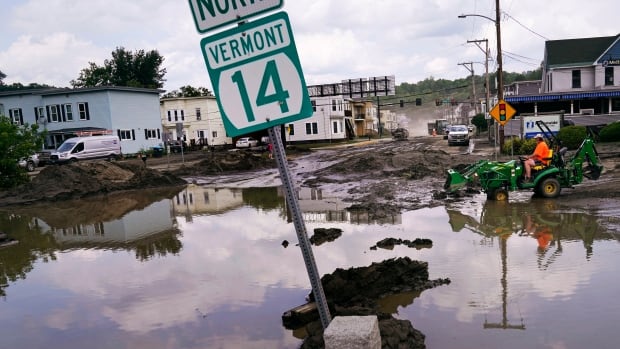Waves of severe thunderstorms in the U.S. during the first half of this year led to $34 billion US in insured losses, an unprecedented level of financial damage in such a short time, according to Swiss Re Group, as climate change contributes to the frequency and severity of violent meteorological events.
Damages from convective storms in the U.S., those that can come with hail, lightning, heavy rain and high winds, accounted for nearly 70 per cent of the $50 billion US in global catastrophic damages so far this year, the reinsurer said Wednesday. Those global figures include earthquakes in Turkey and Syria.
The storms in the U.S. were so severe, there were 10 that resulted in damages of $1 billion US or more, almost double the average recorded over the past decade, according to Swiss Re, and Texas was the state most severely effected.
“The effects of climate change can already be seen in certain perils like heatwaves, droughts, floods and extreme precipitation,” Swiss Re Group Chief Economist Jerome Jean Haegeli said in a prepared statement. “Besides the impact of climate change, land use planning in more exposed coastal and riverine areas, and urban sprawl into the wilderness, generate a hard-to-revert combination of high value exposure in higher-risk environments.”
There have been a multitude of high-profile meteorological events to start the second half of the year including heatwaves in the U.S., storms and floods across Canada, northwestern China and southern Europe, and wildfires on Greek islands, Italy and in Algeria.
Damages and insurance losses from those events are still being tallied, Swiss Re said.
The figures for the first half of the year are in line with a report last month from another reinsurer, Munich Re, which said the series of thunderstorms that raked Texas in June was the most expensive single event in the U.S. for the year so far. The overall loss from those storms alone is estimated at approximately $8.4 billion US.
“Devastating storms, which now seem to be the norm rather than the exception, are expected to continue to grow in intensity and severity,” wrote Marcus Winter, CEO, North America at Munich Reinsurance America.
Evidence of Hurricane Fiona are everywhere in Glace Bay, N.S., nearly eight months after the storm hit. Many homes haven’t been repaired or rebuilt because disaster relief hasn’t arrived, or because there are no contractors available to do the work.
Winter said that it is “imperative” to act immediately in preparing communities for the “physical and financial risks of future climate-related weather events.”
Reinsurers are the insurance industry’s insurers, covering losses that could upend an individual company. Munich Re and Swiss Re have operations across the globe, including the U.S.
Kerry Symons is a businessman and the mayor of Perryton, a town of about 8,500 in the Texas Panhandle, one of the communities struck by a tornado in June. Three of his buildings were damaged and destroyed, including a furniture store. He also lost some vehicles.
Symons said he is like most residents in Perrytown in that he is still arguing with insurance companies. Some residents have sought his assistance as mayor.
“There’s not a whole lot we can do for them as a city,” he explained.

One lesson Symons has learned from the ordeal is the importance of an annual accounting for the cost of what is inside a building and what it would cost to rebuild. One of his buildings, a furniture store, was acquired recently so the valuation was easy. Another building that he has owned for 20 years has proved more difficult.
The increasing frequency of extreme weather has created disruptions within the insurance industry and some insurers have retreated from states that are getting hit hard, such as Florida and California.
The pullback by insurers is happening despite years of skyrocketing premiums for property owners in hard hit states.
State Farm and Allstate have pulled back from California’s home insurance market, saying that increasing wildfire risk and soaring construction costs mean they’ll no longer write new policies in the nation’s most populous state.
Last month Travelers said catastrophe losses doubled in its most recent quarter and the company, considered a bellwether for the insurance industry due to its size, said it lost money.
AAA has said that it will not renew “a very small percentage” of homeowners and auto insurance policies in hurricane-wracked Florida, joining other insurers in limiting their exposure in the Sunshine State despite efforts by lawmakers to calm the volatile insurance market.
AAA insists it’s not leaving Florida, but that last year’s devastating hurricane season had led to an unprecedented rise in reinsurance rates, making it more costly to operate there.
Florida has struggled to maintain stability in the state insurance market since 1992 when Hurricane Andrew flattened Homestead, wiped out some insurance carriers and left many remaining insurers anxious about writing or renewing policies in Florida. Risks for carriers have also been growing as climate change increases the strength of hurricanes and the intensity of rainstorms.


